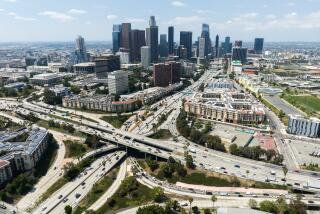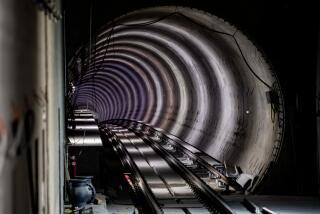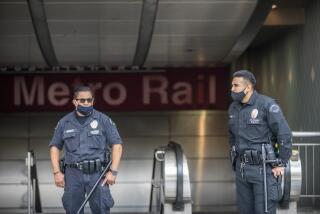Private Operation of RTD Could Cut Costs, Reports Say
- Share via
Amid concern about the Southern California Rapid Transit District’s management, two government reports suggest that bus service can be improved and costs cut dramatically when RTD service is turned over to private firms.
The Los Angeles Department of Transportation, in a report obtained by The Times on Thursday, said that costs have been reduced 38% in the last year since the city took over the downtown minibus from the RTD and farmed it out to a private contractor. The service is the DASH line with its distinctive gray and purple buses.
The second report, by Los Angeles County and 29 cities in the San Gabriel Valley, said turning over 32 RTD lines in the valley to private operators would reduce costs by 33%, or $15 million a year. The cities and the county proposed that a new public agency, the San Gabriel Valley Transportation Zone, be formed to contract the work out to companies.
Much of the DASH savings, city officials said, came from lower costs by the new operators, who pay lower wages than the union-organized RTD.
While the report on the proposed transportation zone in the San Gabriel Valley does not specifically discuss the labor issue, the zone’s leading proponent, Los Angeles County Supervisor Pete Schabarum, has often said that the RTD’s union contracts have boosted operating costs.
Although criticized by unions, such proposals have been pushed and praised by the federal Urban Mass Transportation Administration, which has set aside money to pay for part of the San Gabriel Valley proposal.
And in Los Angeles, the city Transportation Department, using UMTA funds, is planning to contract with private operators to run commuter lines to the harbor area, the San Fernando Valley and the Westside, beginning in mid or late summer, according to Donald Howery, the department’s general manager.
Howery reported that costs had been cut and service improved since the downtown shuttle was taken over by the firm of Diversified Transit.
Cost Comparison
“A comparison of the net costs for the two services indicates a 38% reduction during the first year of DASH,” he said.
Net operating cost for the RTD was $1.05 million, according to his report, compared to $656,898 for DASH.
In addition, “patronage for the first year of DASH operations under private contract increased 10.3% over that experienced by SCRTD during the last year of its operating the downtown shuttle.”
The RTD minibus service downtown carried 997,912 riders in its last year, while DASH patronage amounted to 1.09 million in its first year.
Howery said he believes that the DASH service eliminated features of the RTD minibus operation that he had criticized--lack of distinctively marked vehicles, failure to market the service and “bunching” of buses, with two or three buses arriving at stops at about the same time, followed by long periods without vehicles.
Report by Consultants
The report on the proposed San Gabriel Valley transportation zone was prepared by the consulting firm of Parsons Brinckerhoff Quade & Douglas for the county and the valley cities. It was made to the Los Angeles County Transportation Commission, which allocates state and local funds for transit operations throughout the county. The commission would have to approve formation of the zone.
Under the proposal, 17 long-haul express lines and 15 local lines now operated by the RTD would be operated by private companies under contract to the zone. The RTD would continue to operate six express lines in the area, plus 16 local lines.
By having private companies run these lines, the report said, operating costs within the zone would be reduced from the RTD’s $48.9 million a year to the zone’s $30.2 million by 1991-92.
Part of the early costs would be financed by a federal pilot grant, the report said, but by 1991, the local transit tax, approved by the voters several years ago, plus fare-box revenues would support the system.
Same Fares, Service
The report said the current number of buses, number of stops and fare levels would continue, although it added that operating savings might permit fare reductions. Under the plan, the private operator, under contract, would maintain the same level of service as the RTD.
The report said creation of the zone will not force layoffs of RTD employes.
“The zone will be phased in to correspond to the SCRTD turnover rate, and several important services will be contracted from the RTD,” the report said.
More to Read
Sign up for Essential California
The most important California stories and recommendations in your inbox every morning.
You may occasionally receive promotional content from the Los Angeles Times.










